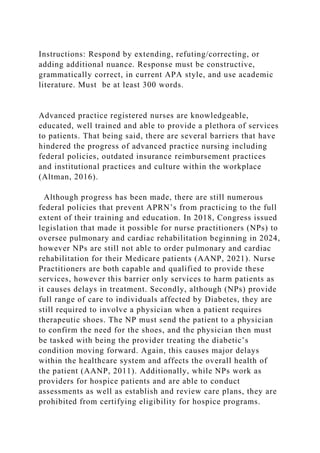Instructions Respond by extending, refutingcorrecting, or adding a.docx
- 1. Instructions: Respond by extending, refuting/correcting, or adding additional nuance. Response must be constructive, grammatically correct, in current APA style, and use academic literature. Must be at least 300 words. Advanced practice registered nurses are knowledgeable, educated, well trained and able to provide a plethora of services to patients. That being said, there are several barriers that have hindered the progress of advanced practice nursing including federal policies, outdated insurance reimbursement practices and institutional practices and culture within the workplace (Altman, 2016). Although progress has been made, there are still numerous federal policies that prevent APRN’s from practicing to the full extent of their training and education. In 2018, Congress issued legislation that made it possible for nurse practitioners (NPs) to oversee pulmonary and cardiac rehabilitation beginning in 2024, however NPs are still not able to order pulmonary and cardiac rehabilitation for their Medicare patients (AANP, 2021). Nurse Practitioners are both capable and qualified to provide these services, however this barrier only services to harm patients as it causes delays in treatment. Secondly, although (NPs) provide full range of care to individuals affected by Diabetes, they are still required to involve a physician when a patient requires therapeutic shoes. The NP must send the patient to a physician to confirm the need for the shoes, and the physician then must be tasked with being the provider treating the diabetic’s condition moving forward. Again, this causes major delays within the healthcare system and affects the overall health of the patient (AANP, 2011). Additionally, while NPs work as providers for hospice patients and are able to conduct assessments as well as establish and review care plans, they are prohibited from certifying eligibility for hospice programs.
- 2. Once again, a physician is required, and additional costs are incurred. Currently, the American Association of Nurse Practitioners is calling on Congress to change many federal laws, including authorizing NPs to order cardiac and pulmonary rehabilitation services for Medicare patients, allowing for NPs to issue therapeutic shoes to diabetics without involving a physician and authorizing NPs to certify Medicare patients for Hospice Care (AANP, 2011). Historically, reimbursement for NP services has been scattered and confusing to say the least. In 1990, APRN direct reimbursement by Medicare was available only in rural areas and skilled nursing facilities. It was not until 1997 that direct reimbursement was made possible in all clinical settings as well as locations, however the rate was 85% of that of a physician. (Journal of Wound, Ostomy and Continence Nursing, 2012). This can be a huge issue, as NPs working in their own offices receive 15% less reimbursement than a physician’s office would. Furthermore, there is so much variability in Medicaid reimbursement between different states at a time when nurse practitioners are expected to take care of record numbers of patients utilizing Medicaid. Medicaid tends to follow federal guidelines as it relates to reimbursement, therefore the problem with a reduction in payment to nurse practitioners for service charges that are already exceptionally low is extremely significant (Edmunds, 2014). To combat this, nurse practitioners are bringing this to the federal level, and asking that NPs be reimbursed at the same rate as physicians when caring for Medicaid patients. Another barrier to the progress of advanced practice nursing is the culture of many settings where physicians and NPs interact on a daily basis. Although NPs possess the specific skillsets to diagnose, prescribe and treat, there is often physician opposition to independent NP practice, which is free from oversight or supervision (Schirle, et.al, 2018). There is also a
- 3. major lack of understanding of the NPs role, and lack of recognition on a professional level. Studies have shown that NPs report lower job strain and increased job satisfaction when given higher levels of autonomy rather than being micromanaged (Schirle, et. al,2018). To manage this widespread issue, relationships between NPs and physicians should be improved and there should be more education provided as to the scope of the NPs role. Further, the NP should be treated with respect and professionally recognized for the services that they provide on a daily basis. Lastly, an appropriate amount of autonomy should exist for NPs to utilize their knowledge, educations and skillsets. By doing this, job satisfaction and productivity is increased, and patients are cared for by an NP that feels valued in the workplace. References AANP Federal Policy Priorities . American Association of Nurse Practitioners. (2021). https://www.aanp.org/advocacy/federal/federal-issue- briefs/aanp-federal-policy-priorities. Altman, S. H. (2016, February 22). Removing Barriers to Practice and Care . Assessing Progress on the Institute of Medicine Report The Future of Nursing. https://www.ncbi.nlm.nih.gov/books/NBK350160/. Edmunds, M. W. (2014). Important NP Issues. The Journal for Nurse Practitioners , 10 (9). https://doi.org/https://www.npjournal.org/article/S1555- 4155(14)00615-1/fulltext. Reimbursement of Advanced Practice Registered Nurse Services
- 4. A Fact Sheet. (2012). Journal of Wound, Ostomy and Continence Nursing , 39 (2), 7–16. https://journals.lww.com/jwocnonline/fulltext/2012/03001/reim bursement_of_advanced_practice_registered.4.aspx. Schirle, L., Norful, A. A., Rudner, N., & Poghosyan, L. (2018, December). Organizational facilitators and barriers to optimal APRN practice: An integrative review . Health care management review. https://pubmed.ncbi.nlm.nih.gov/32865939/. Instructions: Respond by extending, refuting/correcting, or adding additional nuance. Response must be constructive, grammatically correct, in current APA style, and use academic literature. Must be at least 300 words.
